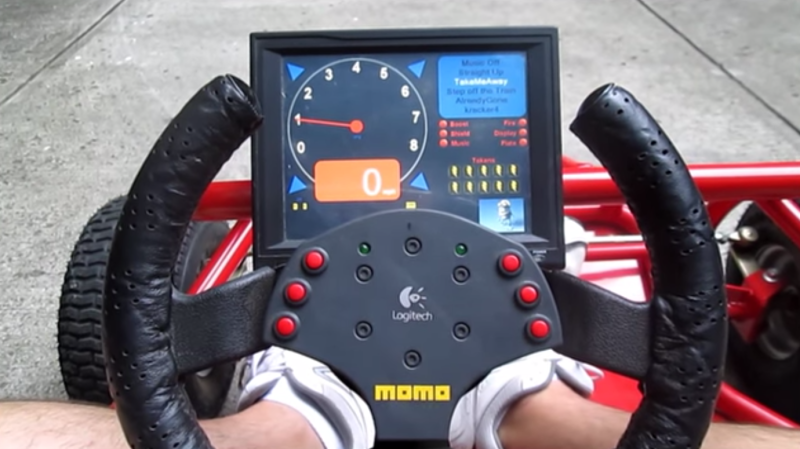If you’ve ever had a casual go-kart experience, you might be able to relate to [HowToLou]. He noticed that whenever he tried to race, the same situation inevitably always happened. One racer would end up in front of the pack, and no one else would be able to pass them. The result was more of a caravan of go-karts than an actual race. That’s when he realized that video games like Mario Kart had already figured out how to fix this problem long ago. [Lou] took ideas from these games and implemented them onto a real life go-kart in order to improve the experience. The result is what he calls a Flash Kart.
The key to improving the experience was to add more features that you don’t normally get in a real word go-karting experience. The Flash Kart uses an electronic drive system that is controlled by computer. This setup allows the computer to limit the speed of the kart so they are all the same. The system includes a Logitech gaming steering wheel with built-in control buttons. There is also a color LCD screen mounted as a heads up display. The screen displays the racer’s speed in miles per hour, as well as multiple MP3 music tracks to choose from. The system provides the user with a limited number of speed boost tokens, listed on the heads up display. The user can also view their current ranking, their location on the track, or even get a view directly behind them.
The back of the kart includes a 23″ LCD screen that shows other players who you are and what team you are on. For added fun, the rider can display taunting messages to other racers using this screen. The front of the kart includes a laser cannon for shooting other karts as well as a “token scoop” sensor. This allows the riders to pick up virtual items such as laser cannon ammo, shields, or extra speed boost tokens.
To pack in all of this added functionality, [Lou] started with a typical go-kart chassis. From there, he built a custom fiber glass shell for the back-end. This houses most of the sensitive electronics. The system is powered by three 12V deep cycle batteries. A 15HP electric motor drives the rear wheels. The throttle is controlled with a gas pedal that simply feeds to a sensor that is hooked up to the control computer. The heart of the system is a computer that runs on a 2.6Ghz small footprint Zotac motherboard with Windows XP. The software is custom written in C#. The computer is plugged into a miniLAB 1008 interface board. This is how it communicates with all of the various sensors. The interface board is also used to control a number of relays which in turn control the speed of the kart.
Unfortunately [Lou] built this kart years ago and doesn’t include many details about what sensors he is using, or how the software works. Still, this was such a cool idea that we had to share it. Be sure to watch [Lou’s] video below to see the kart in action.
















This.is.AWESOME!!!
Looks like it could do with a bit more on the safety side, seatbelts & such. But that’s just a detail.
Nice design and all, but if you have to add “foo foo game stuff” to kart racing, you’re doing it wrong.
different people have fun in different ways.
I think this is a good idea for lower speed karts (sub 25mph). Its always more fun to drive the faster eurokarts, but they’re so expensive.
Very nice indeed! FIA should consider these ideas for F1. (c:
BSoD suddenly got a very real meaning.
also relays for speed control ?
Perhaps the accelerator pedal is a potentiometer, and the relays switch out resistors to alter the overall resistance of the throttle input. That would mean the computer can limit the maximum throttle setting, but the cart would still be able to operate with the computer offline or disabled.
Exactly right, Emily. Also, this was just a concept. I was thinking the next one would be driven by a Rasberry Pi.
Another take on Real Life Mario Kart
https://www.youtube.com/watch?v=w1Iat_WmvrI
“There is also a color LCD screen mounted as a heads up display.”
I don’t think you understand what “heads up display” means.
Yes he is technically wrong but when you consider that he is emulating the heads up display from a video game it makes sense to call it that.
I don’t know that I’d trust the strength of a Logitech gaming steering wheel in an actual go-kart, even before he cut the chunk out of the top of it.
I’m trying to figure out what kind of nut would take a 200 dollar steering wheel and hack it up just to get 6 pushbuttons, instead of… oh I dunno… BUYING SIX PUSHBUTTONS FOR 2 BUCKS A POP!!!
Cool go-kart! But all the cool features aren’t really useful if you only build a single one, right?